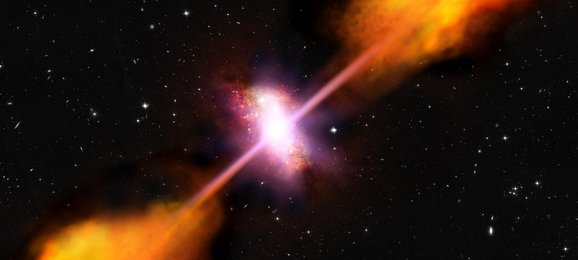Groningse astronomen verklaren raadsel van koel gas in hete quasars

Een team van sterrenkundigen met daarin Peter Barthel en Pece Podigachoski van de Rijksuniversiteit Groningen heeft een verklaring gevonden voor een vijftig jaar oud raadsel waarom koel gas uit hete quasars stroomt. Nieuwe waarnemingen duiden erop dat het koele gas hoogstwaarschijnlijk ontstaat bij de snelle vorming van sterren in het moedersterrenstelsel van de quasar en dat het door sterexplosies naar buiten wordt geblazen. Het artikel van de sterrenkundigen is geaccepteerd voor publicatie in het vakblad Astrophysical Journal Letters.
Een quasar is een fel stralende kern van een sterrenstelsel. In het vroege heelal kwamen veel quasars voor. De kern van een quasar straalt fel door de invloed van een zwaar zwart gat in het centrum dat materie aanzuigt die daardoor heet gaat gloeien. De hittestraling is kenmerkend voor quasars.
In 1966 ontdekten sterrenkundigen tot hun verrassing dat quasars niet alleen heet, maar ook koel gas herbergen. Dat gas bleek bovendien snel te bewegen. De astronomen proberen al vijftig jaar te ontrafelen waar het koele gas vandaan komt, hoeveel er is en waarom het snelheden van duizenden kilometers per seconde kan bereiken.
Peter Barthel (Kapteyn Instituut, Rijksuniversiteit Groningen): "Ook wilden we weten hoe belangrijk dit soort gaswinden zijn in het moederstelsel van de quasar en wat het netto effect ervan is in het vroege heelal. Deze sterrenstelsels groeien namelijk uiteindelijk tot stelsels als onze Melkweg en dat proces willen we begrijpen."
Een internationaal team van sterrenkundigen besloot om met de Herschel-ruimtetelescoop naar een aantal quasars te kijken. Uit de waarnemingen blijkt dat het koele gas met name voorkomt in die quasars waarin ook veel sterren worden gevormd. Barthel: "Kennelijk heeft snelle stervorming in quasar-moederstelsels iets van doen met die koele gaswinden."
Barthel werkte deze veronderstelling vervolgens nader uit samen met zijn promovendus Pece Podigachoski en met collega's Belinda Wilkes van de Harvard sterrenwacht en Martin Haas van de universiteit van Bochum. Ze vermoeden dat de winden wordt aangewakkerd door sterren die exploderen als er veel en snel sterren worden gevormd.
De sterwinden zouden weleens een natuurlijke rem kunnen zijn op de vorming van veel meer sterren en van grotere sterrenstelsels. Barthel: "Want hoewel theoretisch gesproken sterrenstelsels heel groot zouden kunnen worden, komen we ze in de praktijk niet tegen."
Artikel
"Starburst-driven superwinds in quasar host galaxies." Peter Barthel, Pece Podigachoski, Belinda Wilkes & Martin Haas. Geaccepteerd voor publicatie in Astrophysical Journal Letters (gratis preprint).
Meer nieuws
-
19 december 2025
Mariano Méndez ontvangt Argentijnse RAÍCES-prijs
-
18 december 2025
Waarom innoveren, en voor wie?
-
17 december 2025
Ben Feringa wint Feynmanprijs
